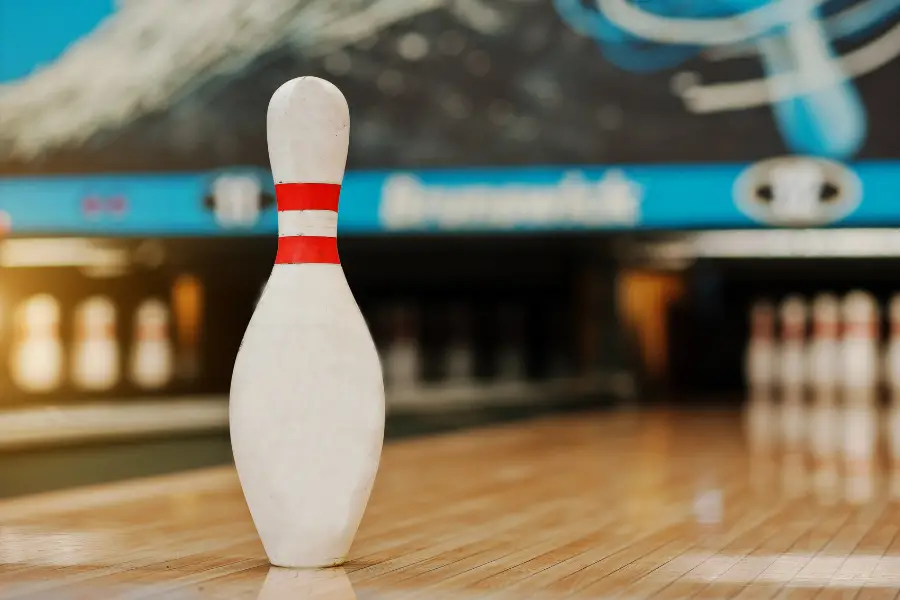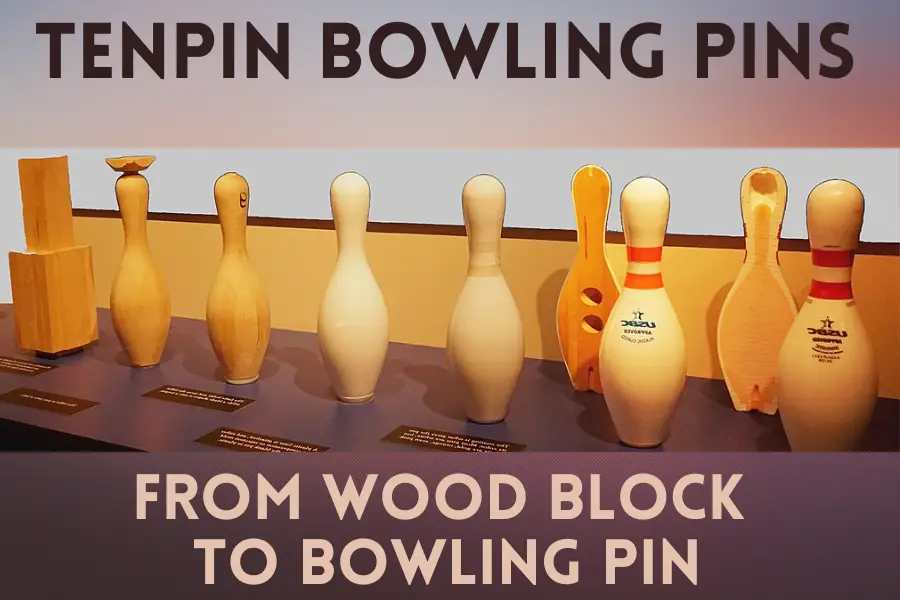
Introduction
Have you ever been on the slick lanes of a bowling alley, launching your ball toward those ten unmistakable targets and wondered, “What are bowling pins made of?” If so, strap in because you’re about to embark on a compelling journey through the surprisingly intricate world of bowling pin construction.
Unbeknownst to many, this seemingly simple sports equipment has evolved over centuries, from its humble wooden beginnings to advanced composite materials that offer enhanced performance and durability.
By peeling back the layers – literally and figuratively – we’ll reveal the true composition of those iconic pins that make your favorite strikes possible.
Key Takeaways
- Bowling pins can be made from a variety of materials, including traditional wooden pins, plastic pins, and composite materials.
- Traditional wooden bowling pins are typically made from solid blocks of maple wood and have been used for over 200 years due to their durability and reliability in the sport.
- Plastic bowling pins offer advantages such as consistency and affordability due to their precise shaping through injection molding techniques. However, they may not withstand powerful shots or repeated use as well as wooden pins.
- Composite materials like urethane and resin have revolutionized bowling pin manufacturing by providing enhanced performance, durability, and customization options. These modern materials offer consistent pin action while withstanding frequent impacts without chipping or cracking.
Materials Used In Bowling Pin Manufacturing
Bowling pins can be made from a variety of materials, including traditional wooden pins, plastic pins, and composite materials.
Traditional Wooden Pins
Bowling as a sport has a rich history and traditional wooden pins play an integral part in this heritage. Originally made from solid blocks of maple, these pins were a testament to the resilience and durability of wood.
The manufacturing process often began with hard rock maple logs that were cut into small blocks of wood. These were then skillfully fashioned into the iconic pin shape using a high-precision lathe.
Maple remained as king in pin construction until late 1800s due to its superior performance despite experiments with aluminum and plastic materials being conducted in parallel.
Despite advances in technology, many bowlers fondly remember tournaments where they played on lanes fitted with single block hard rock maple bowling pins—providing not just challenging gameplay but also instilling respect for craftsmanship involved in creating these enduring icons of one of America’s favorite pastimes.

Plastic Pins
Plastic pins are the modern alternative to traditional wooden bowling pins. Made from durable plastics such as polyethylene, plastic pins offer several advantages over their wooden counterparts.
One of the main benefits is consistency.
Another advantage of plastic pins is affordability. While wooden pins require skilled craftsmanship and precision cutting from solid blocks of maple wood, plastic pins can be mass-produced at a lower cost.
However, it’s worth noting that some bowlers claim that the sound and feel of hitting plastic pins differ from hitting wooden ones. The satisfying thud of striking a solid wood pin may be missed by those who grew up playing with traditional bowling equipment.
In conclusion, while wooden bowling pins hold historical charm and authenticity in the sport of bowling, plastic alternatives have become popular due to their cost-effectiveness and uniformity in shape and weight distribution.
Composite Materials
Composite materials have revolutionized the world of bowling pins, offering enhanced performance and durability.
One advantage of using composite materials for bowling pins is their ability to withstand repeated impact without losing their shape or integrity.
Additionally, composite materials allow for greater control over the weight distribution of the pin. Manufacturers can fine-tune the design to achieve optimal balance and stability, resulting in more consistent pin action on every throw.
Furthermore, composite materials provide opportunities for customization. The manufacturing process allows for unique designs and colors to be incorporated into the pin’s exterior surface.
While traditional wooden pins still hold nostalgic appeal for many bowlers, these innovative composite alternatives offer significant advantages in terms of resilience, consistency, and aesthetics.
Regardless of what the pins are made from, the bowling pin weight must still meet the specifications set by the USBC (United States Bowling Congress).
The Evolution Of Bowling Pin Materials
Bowling pin materials have undergone significant evolution, transitioning from traditional wooden pins to the introduction of plastic pins and now the use of advanced composite materials such as urethane and resin.
Transition From Wooden To Plastic Pins
Bowling pins have come a long way since their early days as solid pieces of maple wood. In the mid-20th century, there was a transition from wooden to plastic pins, which revolutionized the sport of bowling.
Plastic pins are made using injection molding techniques, which allow for precise shaping and uniformity. This ensures that each pin is nearly identical, providing bowlers with a more consistent experience on the lanes.
However, it’s important to note that while plastic pins offer benefits such as consistency and affordability, they do have some drawbacks. Plastic tends to be lighter and less durable than wood, which can result in increased pin deflection upon impact from the bowling ball.
Despite the introduction of plastic pins, traditionalists still prefer the feel and durability of wooden bowling pins. Maple wood has proven to be an excellent choice due to its density and strength.
In conclusion, while there has been a transition from wooden to plastic bowling pins over time, both options have their merits. Wooden pins offer tradition and durability while plastic provides consistency at an affordable price point.
Advancements In Composite Materials
Composite materials have revolutionized the world of bowling pins. These innovative materials, such as urethane and resin, offer enhanced performance and durability compared to traditional wooden or plastic pins.
One major advantage of composite materials is their ability to provide consistent pin action. Unlike wood, which can exhibit slight variations in density and hardness, composite materials ensure that each pin performs predictably on impact with the bowling ball.
Additionally, composite materials are known for their exceptional durability. They can withstand frequent impacts without chipping or cracking like wooden pins often do over time.
Furthermore, advancements in composite material technology allow manufacturers to finely tune the weight distribution within a bowling pin.
However, it’s worth noting that some bowlers still prefer the nostalgic feel of traditional wooden pins or the affordability of plastic ones.
In conclusion, advancements in composite materials have greatly influenced the manufacturing of bowling pins by offering superior performance and durability compared to traditional options like wood or plastic.
Benefits And Drawbacks Of Different Bowling Pin Materials
Wooden pins offer a traditional and durable option, while plastic pins provide consistency and affordability. Composite materials, on the other hand, offer enhanced performance and durability.
Wooden Pins: Traditional And Durable
Wooden bowling pins have been a staple in the sport for over 200 years, and it’s not hard to see why. Crafted from solid blocks of maple wood, these pins are known for their traditional beauty and remarkable durability.
One key advantage of wooden pins is their ability to absorb impact, which helps maintain pin integrity over time. When a ball hits a wooden pin, the wood flexes slightly and absorbs some of the force, preventing damage that could occur with more rigid materials.
Furthermore, the natural grain pattern on wooden pins enhances grip when they are picked up by pinsetters or bowlers alike.
Bowling alleys must adhere to strict specifications set by organizations like the United States Bowling Congress (USBC), including weight and shape requirements for each pin used in official competitions.
Overall, wooden bowling pins offer bowlers a classic experience rooted in tradition and reliability.
Plastic Pins: Consistency And Affordability
Plastic bowling pins have gained popularity in recent years due to their consistency and affordability. These pins are typically made from a durable plastic material that provides a consistent bounce and reaction when struck by a bowling ball.
One of the key benefits of plastic bowling pins is their affordability. They are generally less expensive compared to traditional wooden or composite pins, making them more accessible for recreational bowlers or those on a budget.
Moreover, using plastic bowling pins ensures fairness as each pin has consistent weight and dimensions. This allows bowlers to focus on improving their technique and accuracy without worrying about variations in pin behavior.
While plastic bowling pins offer many advantages in terms of consistency and affordability, it’s important to note that they may not provide the same level of durability as traditional wooden or composite options.
If you’re an avid bowler who frequently competes or plays at high levels, you might prefer the sturdiness offered by other materials.
If you are looking for bowling pins for sale to use in your backyard, inside your home, or with small children, then plastic pins are often the way to go.
In conclusion, while traditionally made with maple wood, today’s market offers alternative choices such as plastic materials for manufacturing bowling pins – providing consistency and affordability benefits to bowlers across all skill levels while still maintaining the challenge and fun associated with this beloved sport.
Composite Materials: Enhanced Performance And Durability
Composite materials have emerged as a popular choice for bowling pin manufacturing due to their enhanced performance and durability. These materials, such as urethane and resin, offer distinct advantages over traditional wooden or plastic pins.
One key benefit of composite materials is their ability to provide consistent pin action on the lanes. The composition of these pins ensures that they maintain a uniform weight distribution, resulting in more predictable rolling patterns.
Moreover, composite materials offer increased durability compared to wooden pins. They are less susceptible to wear and tear from repeated impacts with bowling balls, making them last longer and reducing the need for frequent replacements.
In addition to performance and durability, composite materials allow for greater versatility in design and customization options.
Overall, the use of composite materials in bowling pin manufacturing has revolutionized the game by providing bowlers with improved performance capabilities along with long-lasting reliability on the lanes.
Video – What are Bowling Pins Made of?
From layers of wood glued together, to the logo being painted on, you will see every material that goes into a traditional wooden bowling pin in this video
Conclusion
In conclusion, bowling pins are primarily made of a solid piece of maple wood. This traditional material has been used for over 200 years due to its durability and suitability for the sport.
The evolution of bowling pin materials reflects advancements in technology. Transitioning from wooden to plastic pins allowed for consistency and affordability, making it easier for bowling alleys to maintain their equipment.
Despite these innovations, maple wood continues to be favored for its resilience and reliability on the lanes.
Crafted with precision using techniques like gluing blocks of hard rock maple together before shaping them on a lathe, each bowling pin is carefully assembled under pressurized conditions.
So next time you step into a bowling alley and knock down those pins with your trusty ball, remember that they are made from quality maple wood designed specifically to withstand countless hours of fun-filled strikes and spares!
FAQs:
Bowling pins are traditionally made of hardwood, specifically maple wood, which is known for its durability and resistance to damage.
No, not all bowling pins are made of the same material. While most modern bowling pins are still made from hardwood, there are also synthetic options available that are often used in recreational or casual settings.
Bowling pins are made from hardwood because it provides better stability and durability during gameplay. Hardwood materials like maple can withstand repeated impacts from heavy balls without breaking or splintering easily.
The construction process for making bowling pins involves precision shaping and finishing techniques to create a balanced and consistent product. Skilled craftsmen use specialized machinery and tools to ensure each pin meets specific weight, height, and shape requirements for optimal performance on the lanes.
